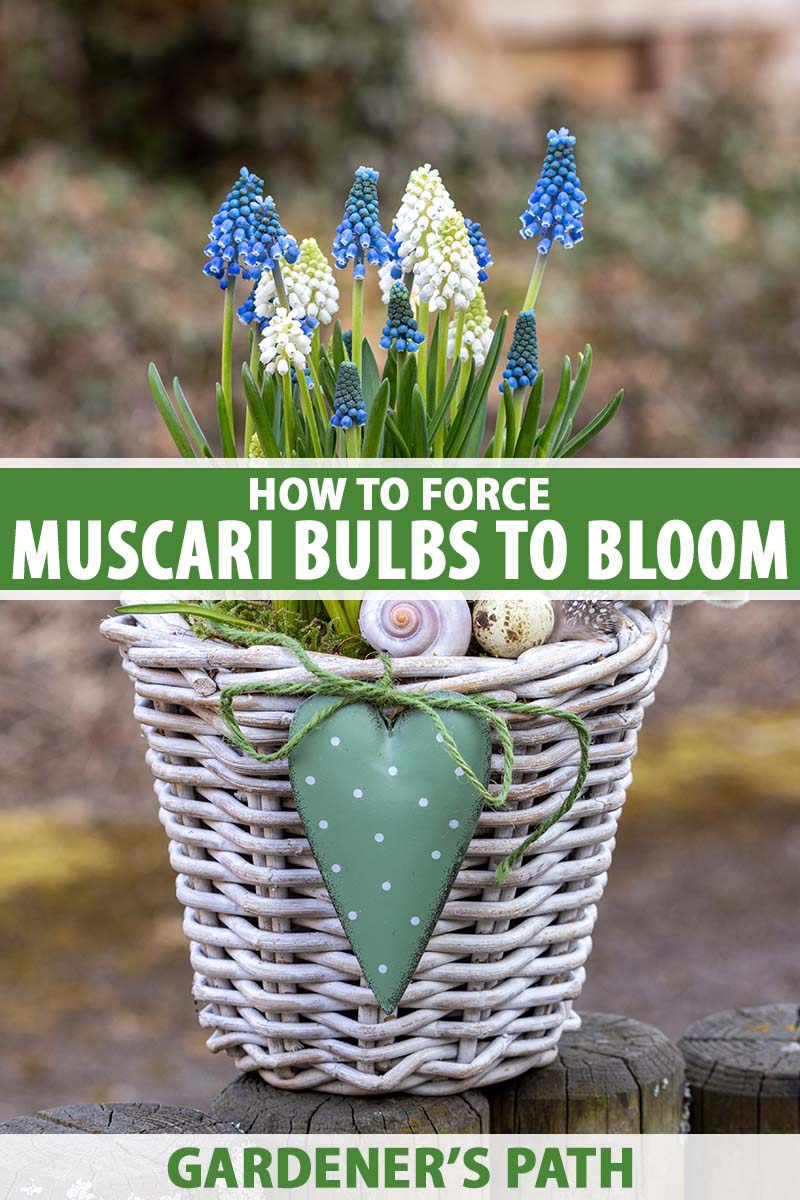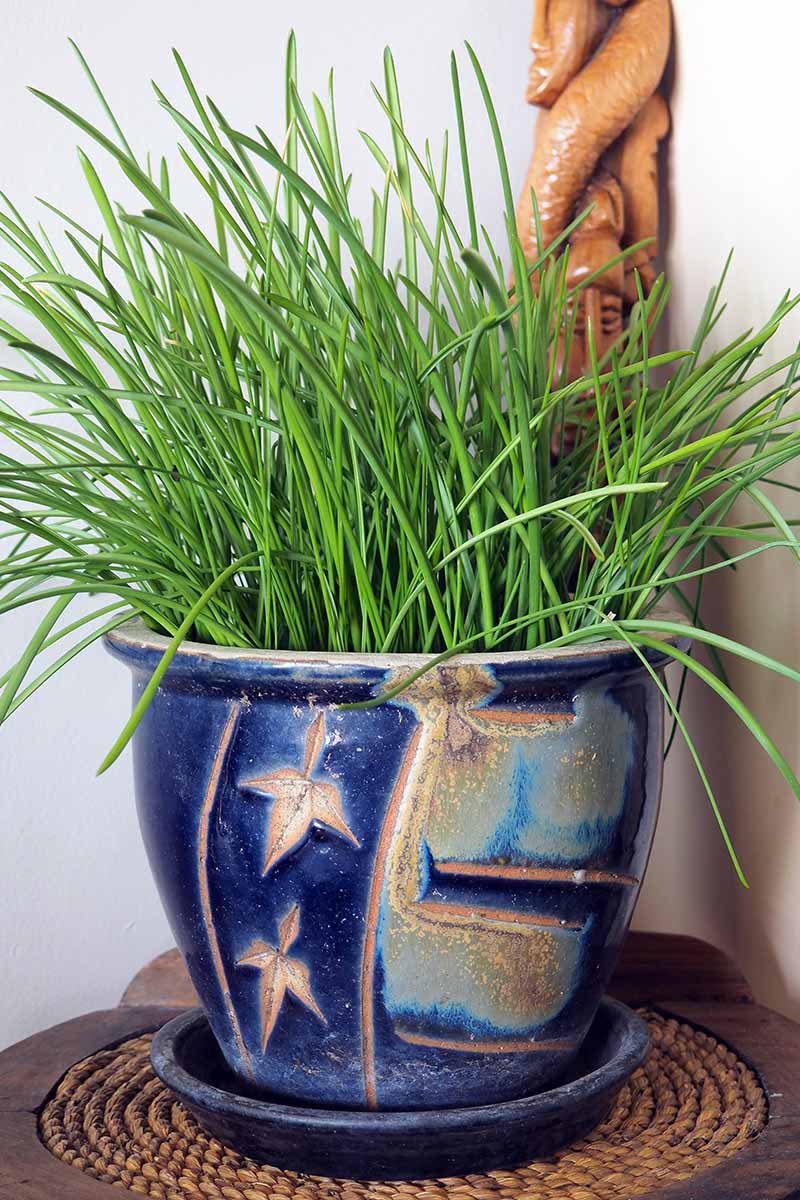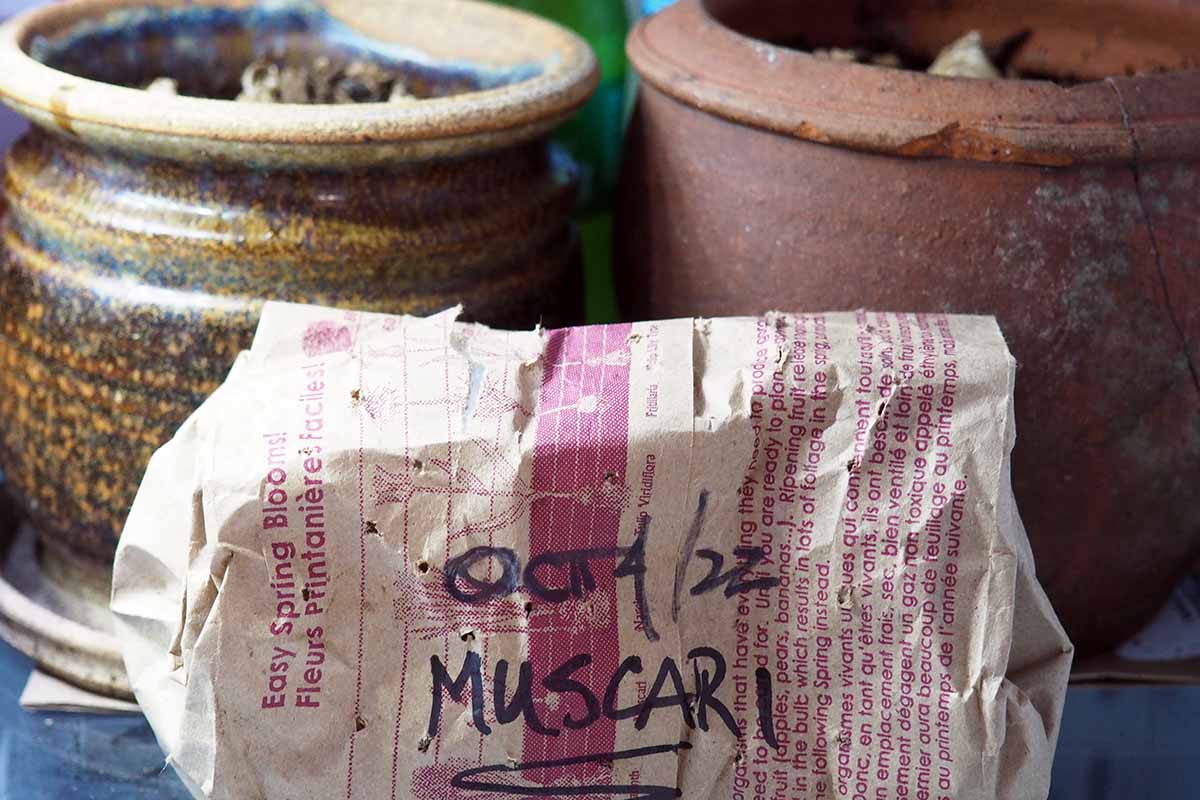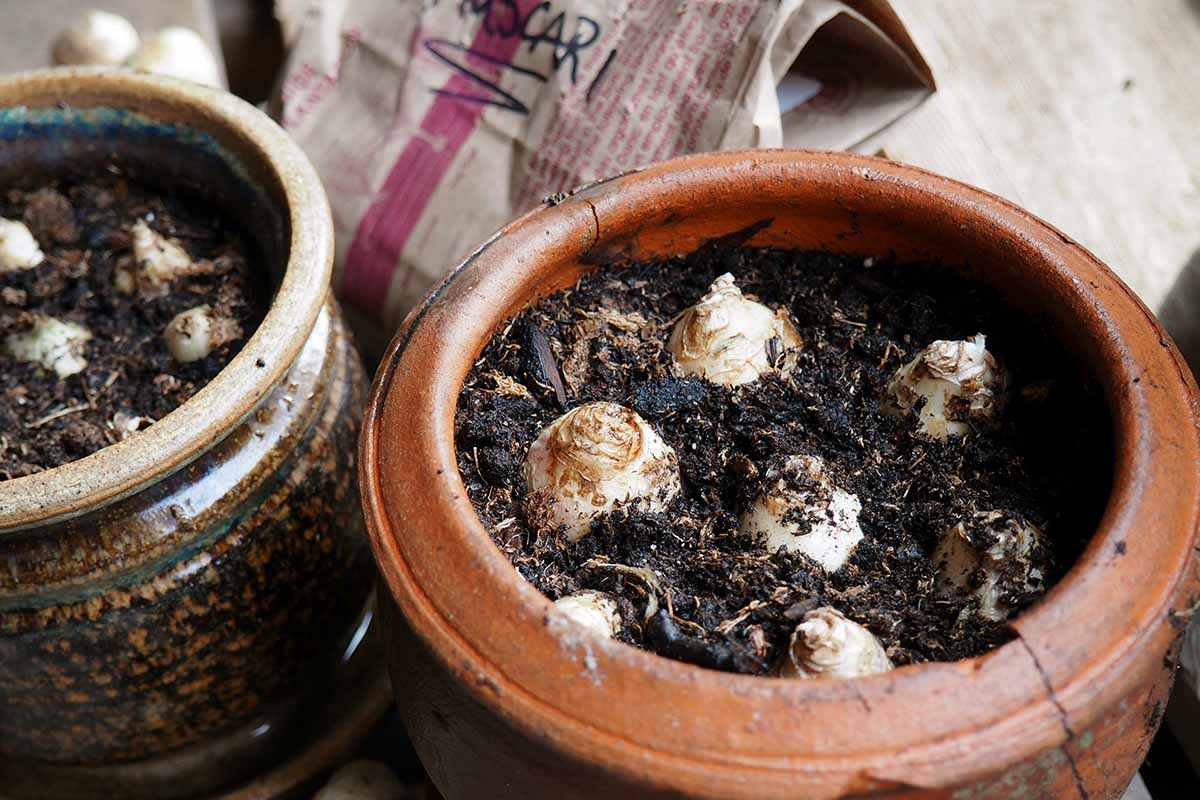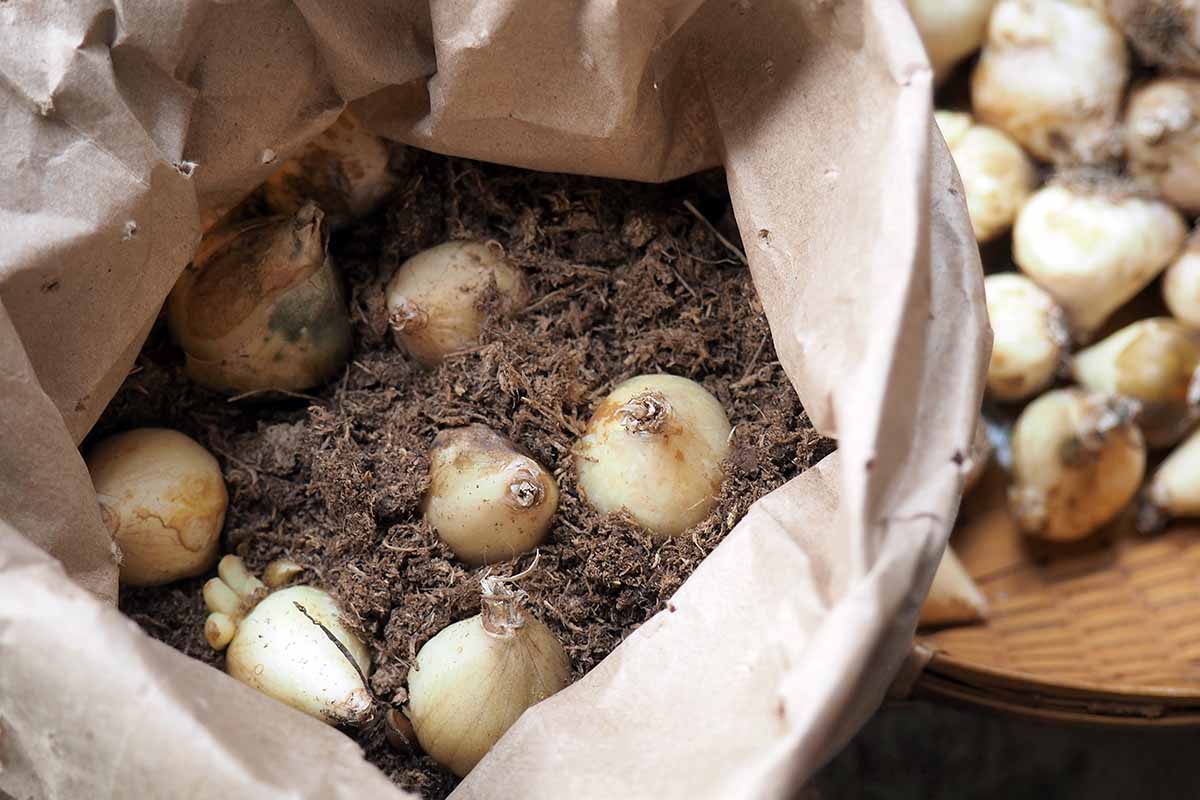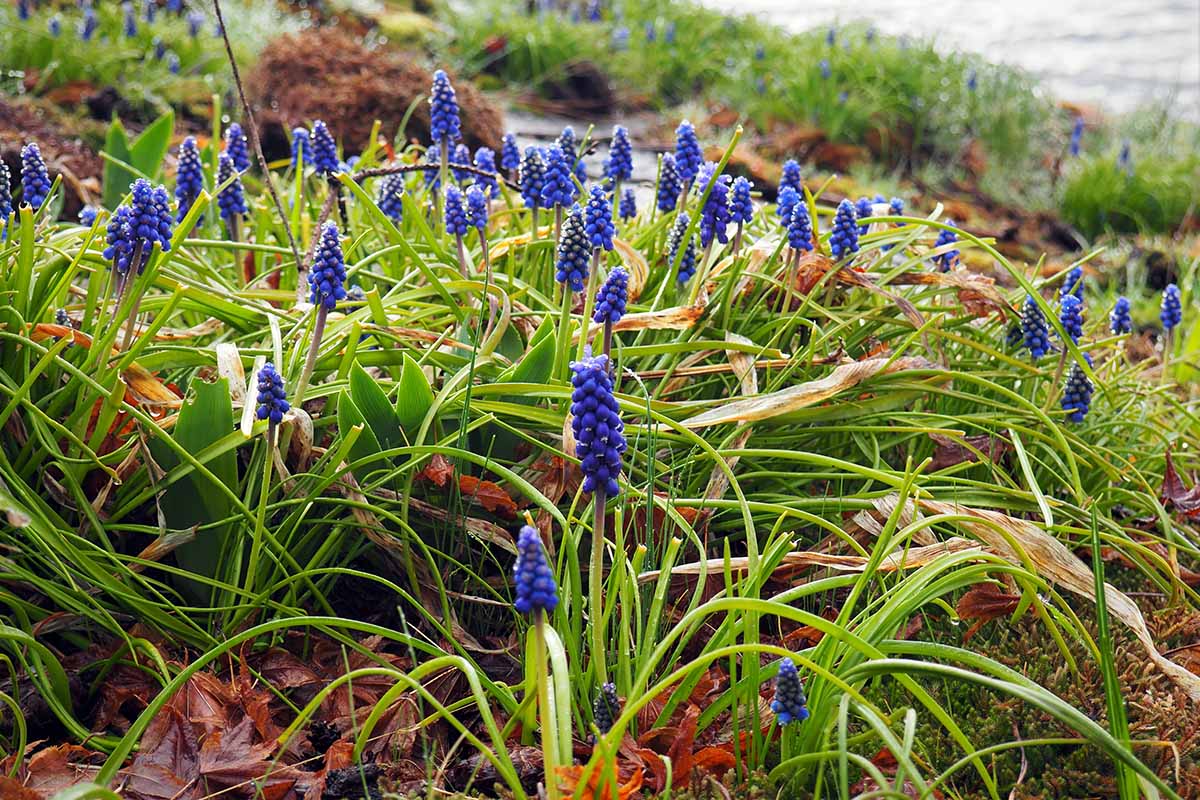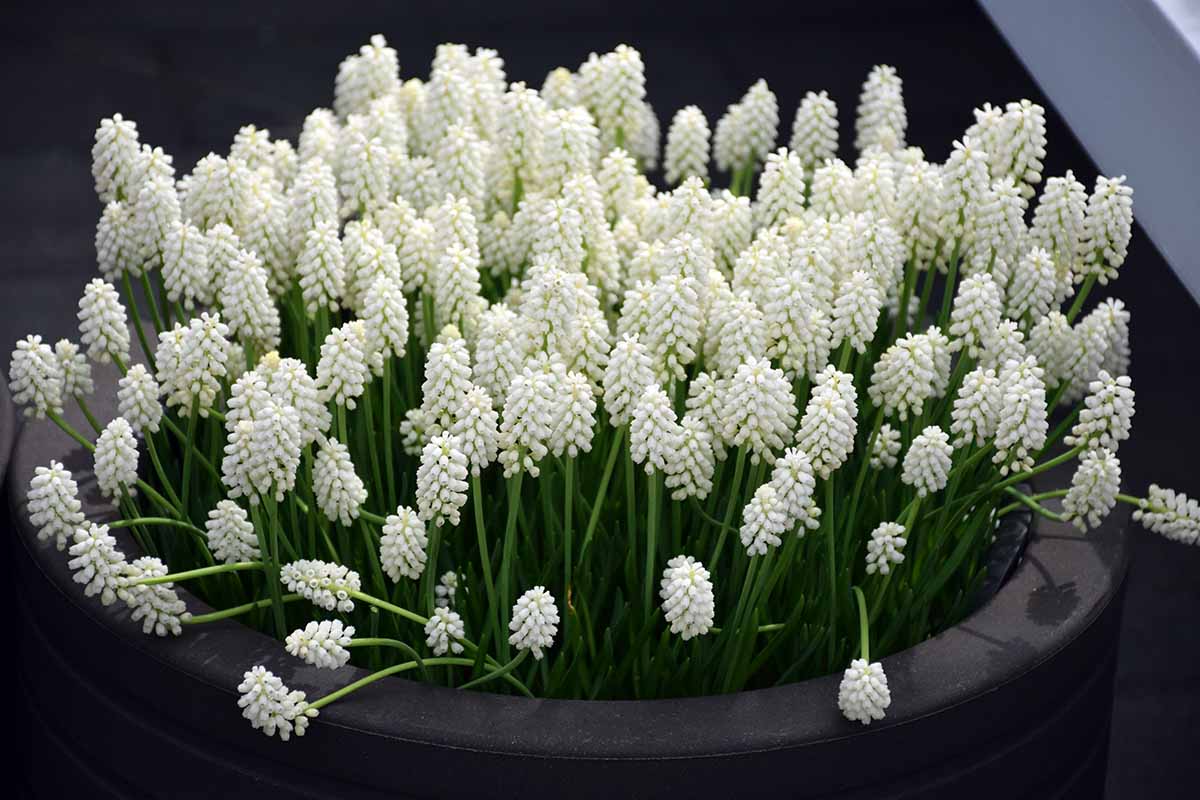But for something a little different, a pretty option to consider is Muscari, or grape hyacinth. We link to vendors to help you find relevant products. If you buy from one of our links, we may earn a commission. Beloved for their explosion of color in the early spring garden, you don’t have to wait for plants to emerge from dormancy outdoors to enjoy their striking blooms – these easy-care bulbs respond well to any forcing method for indoor enjoyment even at the coldest times of year. If you feel the need for a fabulous burst of colorful flowers this winter, grab some bulbs and read on to learn to force grape hyacinths indoors! Here’s everything we’ll cover in this guide:
Harvest or Purchase Bulbs
Grape hyacinth are perennials in the Muscari genus of the Asparagaceae family. These robust, cold-hardy plants emerge in the late winter to early spring garden, adding color and charm in small stands or large drifts. After flowering, the bulbs go dormant over summer, losing their foliage until early autumn, when they often resume growth and send up a few grass-like shoots. To harvest bulbs for forcing, tag an existing clump while plants are flowering. Insert a plant tag into the soil or outline the clump with pebbles. This is important to remember to do if you wish to start with existing bulbs that are planted outdoors, because after the foliage dies back, it’s hard to remember exactly where they are! You might want to map out the area and add a note in your gardening journal as well. In midsummer while they are still dormant, dig them up and select the biggest and healthiest for indoor growth. As a general rule of thumb with flower bulbs, the bigger they are, the larger the flowers they produce will be, and often in greater quantities as well. When plants emerge, popular grape hyacinth cultivars generally grow in the range of six to 12 inches in height. For those that don’t have their own stock available, muscari bulbs can be purchased in early autumn from nurseries and online. Grape Hyacinth You might like these Muscari armeniacum bulbs, available in a variety of package sizes from Dutch Grown. Our guide to 9 of the best grape hyacinth varieties also showcases a selection of cultivars, both popular and unusual.
Chill Time
To get the best display of flowers, always start with large, healthy bulbs. Due to their demure size, mass planting in containers gives the greatest impact – just like you might do in the garden. For forcing, bulbs are planted much closer, so they’re almost touching. A small four- to six-inch container can hold several bulbs, resulting in a beautiful cushion of color to enjoy in your home. They can be forced in a variety of mediums, but the most important consideration is chill time – the cold treatment required for flowering. Muscari need a minimum of eight weeks in a cold, dark environment in the range of 38 to 45°F (about 3 to 7°C). An unheated cellar, garage, or shed will work just fine, provided temperatures are consistently cold. Alternatively, bulbs can be chilled in the refrigerator. But take care not to place them close to ethylene-emitting fruits and veggies such as apples, which can negatively impact flower production.
Potted Bulbs
Because of their compact size, small pots are perfect for forcing. Use pots with drainage holes. I like to add a one- to two-inch layer of drainage material to the bottom, such as pebbles or broken pottery, or you could place a small screen over the hole to keep potting material from passing through. Check the soil occasionally to ensure it stays slightly moist. Containers placed in the fridge may be lightly covered. De La Tank’s House Plant Mix is a nutrient-rich potting soil choice suitable for this purpose that resists compaction, so bulbs stay healthy. De La Tank’s House Plant Mix One-, eight-, and 16-quart bags are available at Arbico Organics. Cover bulbs loosely with soil, leaving the tips – or necks – exposed. Water thoroughly, then move containers to a cool, dark environment with a constant temperature of 38 to 45°F, such as a basement, cellar, garage, or refrigerator. In eight to 10 weeks, or when shoots reach about two inches tall, bring the container out of cold storage. Move it to a sunny window in a cool room, with a temperature within the range of 50 to 65°F (about 10 to 18°C). Avoid cold drafts as well as warm air blowing from heat vents. Place a small saucer under pots to keep things tidy and catch any drips. Keep the soil slightly moist but not wet, watering when the top half-inch of the soil dries. Turn containers about a quarter-turn every few days to promote even growth. Muscari bulbs will bloom two to six weeks after emerging from their cold treatment.
Paper Bag Method
When forced in wet conditions in a soil-filled container, muscari bulbs respond with flowers and an abundance of foliage. But maybe this isn’t the look you’re going for. To minimize foliage growth, try the paper bag method instead, which breaks cold storage into two periods of dry and wet. Simply punch holes in a small paper bag and add two or three inches of sawdust or peat moss to the bottom. Bury bulbs in the storage medium and place the bags in a cool, dark environment in the range of 38 to 45°F for four weeks. This is the dry storage period, which reduces the rooting period and results in shorter foliage with less potential floppiness. When four weeks have passed, prepare containers and plant as outlined above – make sure you have everything ready before you begin so the bulbs will maintain their chill during planting. Once they are planted, return the containers to cold storage for another four weeks, bringing them out once shoots are a couple of inches tall. The bulbs can also be left in their bags for the full eight to 10 weeks and then planted up when they come out of cold storage, if you prefer.
Water Flowers
To force blooms in water, chill them for four weeks using the paper bag method. Prepare bud vases or a shallow dish by filling the base with a one- to two-inch layer of small pebbles or glass marbles. If desired, add a layer of florists’ moss over the pebbles. Moisten the pebbles with a couple teaspoons of water, just enough so that it pools at the bottom of the pebble layer. Nestle the bulbs into the pebbles, but don’t allow them to sit in water – only the basal plate and roots should touch the water. Return the vase or dish to cold storage for another four weeks, adding water as needed. After the second period of chilling, move containers into a sunny location in a cool room. Add a bit of water every few days as needed, and turn the dish or vase every few days for even growth. Enjoy the blooms!
Care After Flowering
Grape hyacinths that have been forced to bloom can be planted outdoors as soon as the ground thaws and there’s no longer a risk of frost in the forecast. After flowering, keep the soil lightly moist and place the container in bright but indirect light. After all danger of frost has passed, place containers outdoors in a sheltered spot with bright, indirect light for two weeks to acclimatize to outdoor conditions. Plant bulbs at a depth of twice their length, and keep the soil moist until plants go dormant. Some gardeners caution against planting bulbs that have been forced to bloom indoors outside in the landscape after flowering. You may find they take an extra season to bloom again or some may fail to thrive, but it’s usually worth a shot if you have the space! Spent bulbs may also be discarded after flowering, if you wish. For more muscari planting and cultivation tips, refer to our guide to growing and caring for grape hyacinths. Use healthy, large bulbs and start them all at once for an impressive burst of color, or start a few successive pots each week over the course of a month to spread out the display. Give them at least eight weeks of cold temperatures before moving containers to a sunny spot for flowers that will appear in just a few weeks. And remember to plant them in the garden once the ground thaws – they’ll continue providing eye-catching, early flowers for years! Do you folks force grape hyacinth indoors? What methods have given you the best success? Share your tips in the comments section below. And for more info on growing colorful indoor plants, check out these articles next:
How to Grow and Care for Christmas CactusHow to Grow and Care for Poinsettia Plants23 Colorful Houseplants to Warm Up Your Home This Winter
